The Madeira Wine Guide
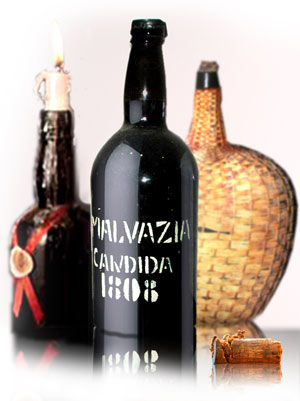
Introduction
For every wine enthusiast there comes a time when he or she discovers fortified wines: Port, Sherry, Muscat, Marsala and, though rarely now, Madeira. Indeed, most fortified wines nowadays are out of fashion for various reasons, probably because they are regarded as too heavy or too sweet. Yet the fascination remains for a minority, who would no doubt prefer to keep it that way. For these wines frequently offer tasting experiences commensurable with any in the wine world while their unpopularity maintains their very reasonable price/quality ratio.
Since the 17th century, the Portuguese island of Madeira has produced some of the world's most famous fortified wines, commercially known all over the world as 'Madeira'. This introduction to the wine region is an abridged version of "The Madeira Wine Guide" compiled by Dr. Wolf Peter Reutter, who first visited Madeira in 1995. He immediately fell in love with the island and its wines and more visits followed. At that time, and even now, it has been difficult to find information regarding Madeira's viticulture and viniculture, so we are especially grateful Dr.Reutter for permission to reproduce this work. It communicates an enthusiasm for these wonderful wines which we hope will be catching.
The History of the "Island of Wine."
The word Madeira means 'wood' in Portuguese and the island had been named so because of its many trees. It forms part of an archipelago in the Atlantic Ocean, located approximately 1100km southwest of Portugal, some 600 km due west of the Moroccan coast and 978 km to the southwest of Lisbon. The archipelago covers a total of 741 square kilometers and consists of the inhabited islands Madeira, with the capital Funchal, and Porto Santo, and two uninhabited islands, 'Ilhas Desertas' and 'Ilhas Selvagens' . Madeira island itself is actually the peak of a 4000m underwater volcano (1861m at it highest point), 55km long and 22km wide, stretching in a west-east direction.
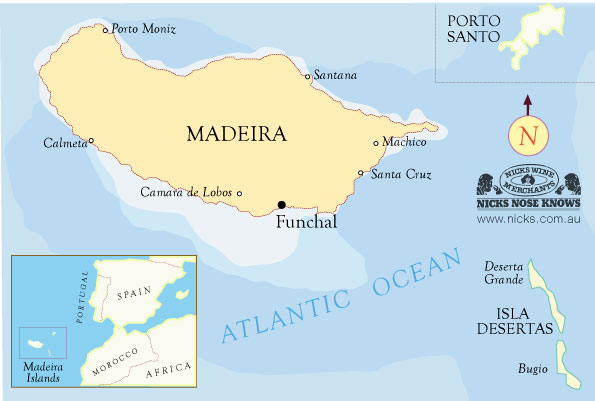
The climate is temperate to subtropical; the main wind direction is from northeast featuring the trade winds for about ten months of the year. The yearly average temperature lies between 16 and 22°C in Funchal with the main rainfall in autumn and spring. Geologically Madeira consists of basalt and tufa, which are also the main components in the volcanic soils of the vineyards. The economy remains based on agriculture, fishing, tourism and of course, wine.
A brief survey of the islands history reveals this has long being the case.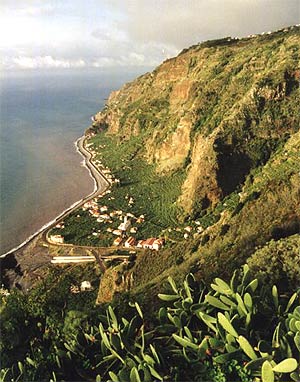 There are some who claim that Madeira's roots lie in ancient history, that it was the remains of the lost island of Atlantis, for example, but there is no archeological proof for this. The island has been shown to appear on numerous 14th century maps under the italic name "Isola de Lolegnane" meaning "island of wood" the same as 'Island of Madeira' in Portuguese on the Medici map of 1351. At least four other maps exist from the 14th century where Madeira island is also shown. It seems that the Phoenicians knew of it and the Arab sailors of Morocco also refer to an island in the west called "El Aghnam". However, the official history of Madeira starts with the 'discovery' of the island of Porto Santo by Joze Gonzalves, also called O Zarco"the cross-eyed" and his fellow officers in 1418. The next year they discovered Madeira island 38 kilometers (23 miles) away.
There are some who claim that Madeira's roots lie in ancient history, that it was the remains of the lost island of Atlantis, for example, but there is no archeological proof for this. The island has been shown to appear on numerous 14th century maps under the italic name "Isola de Lolegnane" meaning "island of wood" the same as 'Island of Madeira' in Portuguese on the Medici map of 1351. At least four other maps exist from the 14th century where Madeira island is also shown. It seems that the Phoenicians knew of it and the Arab sailors of Morocco also refer to an island in the west called "El Aghnam". However, the official history of Madeira starts with the 'discovery' of the island of Porto Santo by Joze Gonzalves, also called O Zarco"the cross-eyed" and his fellow officers in 1418. The next year they discovered Madeira island 38 kilometers (23 miles) away.
Whoever knew of the island did not settle there. It was not until the 15th century that Henry the Navigator promoted colonisation. The first to come were prisoners, but soon there was an established society and something the first settlers brought along was grapevines. However, due to the mountainous terrain, land for vines was always rare and required great efforts to be cultivated. This was achieved with the help of slaves, mostly Guanches, who also built the irrigation-system, known as the 'levadas'. Both the warm climate and volcanic soil ensured that both sugar cane and grape vines thrived. The first reference to wine being produced on the island appears as early as 1485, only some 60 years after the colonization began. This wine was not fortified at first, rather it was dry wine, completely fermented and according to the Aviso da Mosto, who visited the island in 1453, it was already of a high quality.
In 1508 Funchal was granted the rights of a city and the building of a cathedral (the Se) was initiated by King Manoel. Sugarcane growing became less profitable and so in the first half of the 16th century most of the sugarcane plantings were converted to vineyards. The middle of the century saw a solid export of wine to the West Indies, America and England. Even the Spanish usurpation of 1580 did not seriously effect the steady growth of export numbers.
In 1662, negotiations for the marriage between Charles II of England and Catharina of Braganca deliberately omitted Madeira Island because it had become one of the most prized possessions of Portugal. Charles II accepted, nevertheless, and the bonding between England and Portugal brought English merchants to the island. Madeira's exports steadily expanded and were further augmented by two decrees: Firstly in 1643, when Joao IV ordered all ships bound for Brazil to stop at Madeira Island for wines. And secondly, in 1665, when Charles II prohibited the shipping of European goods to the West Indies and America unless these goods were being shipped with British ships and from British ports. But Madeira had been intentionally left out of this decree, because it meant more tax income for the king.
The early American colonies soon became a favourite trading partner for Madeira wine and it was en route from Madeira to America that the positive effect of the long voyage was discovered. The travel and the heat had turned the wine into something completely different and the baked, oxidized taste was to the liking of a growing number of people.
While the European market remained unstable, the US remained solid. General Washington was a great admirer of Madeira wine; it is said that he drank a pint of it daily. His inauguration as president of the United States and the appointment of the city of Washington as the capital were celebrated with Madeira. It's no surprise then, that the Americans also celebrated their Declaration of Independence with the drink.
Right up until the twentieth century, Madeira played an important part in upper class American social life. It was especially favoured in cities such as Baltimore, Boston, Charleston, Philadelphia, New York and Savannah where so-called 'Madeira-parties' took place. At these events, several vintages of Madeira would be consumed with a light meal like terrapin-soup.(To this day, visitors of Savannah can do a "Madeira Tour" at the Davenport House and there still is a "Madeira Club" in Savannah).
In the middle of the 18th century fortification of Madeira wine began, due to overflowing stocks during wars. 'Overflow' wines were distilled and added to the Madeira wine. This procedure was noticed to enhance the durability of the resulting wine. Later the 'estufagem', the heating of the wine, wasented as a substitute for the long and costly sea travels and the beginning of the 19th century saw most companies treating their wines with the estufagem process. From that time on, it was possible to produce Madeira in greater amounts for the growing market as the wine became more and more en vogue. At that time, Madeira became known as the "islof wine". Merchants flocked there to enter the wine business, when in the first half of the 19th century, the Madeira wine trade peaked.
And then quite suddenly, within the space of twenty years, two dramatic events hit the island and destroyed the Madeira wine industry. At first, Oidium (a fungal disease caused by a powdery mildew) infected the vines in 1851. Before the wine industry had recovered, the second plague Phylloxera hit the island in 1872. Only due to the foresight of some shippers did the wine industry survive. In the vineyards, European vines were grafted on Phylloxera resistant American roots. Oidium was battled with sulfur and copper nitrate. Many old vintages were still in cask and only because of the huge amounts of pre-Phylloxera wine could recent vintages be enhanced by blending in the old material.
Still, the overall quality decreased during the following years. Many of the American vines, originally intended for grafting, had begun to grow free in the vineyards. The versatile Tinta Negra Mole was now being preferred to the difficult classical varieties. With the sinking quality and the increasing competition from other fortified wines the Madeira markets dwindled to the point where it was less used for drinking, but more often found its way into the cooking pot, usually as an ingredient for sauces.
In 1913 most of the remaining shippers founded the Madeira Wine Association to fight the decline together. All the British shippers and most of the Portuguese shippers eventually entered this association. Today only six exporting producers are left on the island.
Only after 1970 did quality take an upturn. To meet the standards of the European Community, Portugal issued guidelines concerning the winemaking. In 1980, the Instituto do Vinho da Madeira (IVM) was founded which supervised the whole wine industry on Madeira from growing the wine to filling the bottles. All bottles therefore bear the "Selo de Garantia Madeira", which guarantees a minimum standard. The replanting of the classical grape varieties was also promoted and lower quality vines cleared. Still, one has to remember that such measures take time to impact. Due to Madeira's long production process, it would take at least a few decades to reach its previous heights.
Grape Varieties & Madeira Styles
'Officially' speaking, Madeira grape varieties are classified as either "recommended" for use (like the Sercial, Verdelho, Boal, Malvasia, Terrantez, Bastardo, Tinta Negra Mole) or "authorized" (like the Moscatel, Listrao, Complexa, Triunfo and others).
A grape variety indicated on a Madeira label does not only identify the grape that the wine was made from, but also anticipates a certain taste. There is the dry Sercial, the mild Verdelho, the medium sweet Bual and the rich and oily Malmsey. Terrantez and Bastardo are usually medium dry but rare nowadays since very little is grown on the island. If one of the aforementioned grapes appears on the label, the contents have to be at least 85% from that variety. Only the Tinta Negra Mole, a red grape, is not mentioned on labels and can have tastes from dry to sweet, depending on the elaboration of the wine.
All the above-mentioned grapes are European varieties from the Vitis Vinifera family. Most of the lesser grapes, planted after Oidium and Phylloxera are from the American Vitis Labrusca or Vitis Aestivaldis family. Their main members are: Jacquez, Herbemont, Isabella, Othello and Noah. A simple table wine is produced from these grapes and sold on the island only, since the European Community does not allow export of wines from Vitis Labrusca. The strawberry-like taste or so-called fox-taste makes the distinction to the real Madeira wine made from Vitis Vinifera very easy.
 |
| Bual (Boal). |
Bual (Boal)
Bual is the English name for the Portuguese 'Boal'. Bual is a white variety producing a medium sweet wine. The name was used for a whole group of grapes but today is usually connected with the Bual de Madeira. Grown on the north side around São Vicente and on the south side at Campanário and Câmara de Lobos. It has replaced Malmsey in many vineyards.
The grapes are large, heavy and make good table grapes because of their sweet aroma. The medium sized vine has three-part leaves like the Sercial.
Bual is a good introduction to Madeira wines. It is medium sweet but not too sticky, very aromatic with some acidity balancing the sweetness. Do not let yourself be fooled by the colour which tends to be the darkest of all Madeira wines. The nose has richness and aromas of barley sugar and the palate often has some additional caramel and coffee aromas as well as dried fruits like orange peel or apricot.
Sercial
The English name Sercial is used for the Portuguese 'Cerceal'. Sercial was not grown very much after Phylloxera, but the number of vineyards with Sercial is today on the increase. The vines can be found in the vineyards with the highest altitude, situated in Seixal and Ribeira da Janela on the northern coast of the island.
The medium-size leaves have a hairy under surface and are made of three main parts in the middle with one smaller part to each side. The grapes are very compact, about 18cm long, weighing 170 grams. This variety ripens late, producing a wine with volatile fruit and good, sometimes burning acidity. The high level of acidity makes Sercial almost undrinkable in its youth and in the 16th century, wine from the variety was called "Esgana Cao" (dog-strangler). (Some people have thought that because of its high acidity, Sercial is the same grape as the German Riesling, but this is incorrect). To obtain a maximum aroma as a counterpart, Sercial is the last variety to be harvested, often as late as the beginning of October.
A vintage Sercial wine usually has a golden tawny colour, similar to old German Riesling wines. The nose might display some high volatile acidity. Young Sercials often have a range of fruit aromas with a focus on orange and lemon, but as the wine matures this can shift to a more nutty, turpentine/kerosene like tastes, again similar to old Rieslings. As a wine, Sercial must mature for a long time before it is drinkable. The minimum of twenty years in cask for vintages will just be enough to soften the piercing acidity. Once this wine has found its balance, it makes a perfect aperitif after Champagne. I personally prefer it after a meal to cleanse the palate. On the island, Sercial is often served with soup, nuts, crackers or other snacks.(The cocktail "Madeira on the Rocks" is made of 2/3 dry Madeira of a lesser quality and 1/3 Campari).
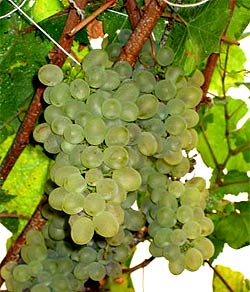 |
| Verdelho. |
Verdelho
Verdelho is also a white grape, being medium dry, tasting somewhere between Sercial and Bual. Just like the other Castas Nobres it was very little grown until 1980, when it began to be planted again. Verdelho, also known as Gouveio in Portugal, gives a medium dry wine. There also is a red variety of Verdelho, the Verdelho Tinto. The variety is grown on the south side of the island from Funchal west to Estreito de Camara de Lobos. On the north side it is grown in the more sheltering pergola style in Ribeira de Janela and Sao Vicente.
The grapes are larger than Sercial and are good table grapes offering a mild wine with slightly nutty flavour, becoming drier as it matures. The vine is very hardy but relatively high and difficult to cultivate. The leaves are of medium size with small hairs on both surfaces.
Verdelho is the main ingredient of a medium dry light wine called "Rainwater" which is very popular in the United States. The cheaper qualities are made from Tinta Negra Mole. The legend around the name tells that the contents of a shipment to Savannah, Georgia, were diluted when a heavy rain hit the casks still standing on the beach. The recipient of the shipment liked the lighter taste and ordered more. The colour of Verdelho is about the same of Sercial, sometimes a little darker. It does not have the piercing acidity of Sercial but displays a more rounded taste. The nose has dried fruits and honey that are also evident on the palate and sometimes there is a little coffee and chocolate.
Verdelho is also used to make the Atlantis White, one of the two official table wines made on the island.
 |
| Malvasia (Malmsey). |
Malvasia / Malmsey
The English name Malmsey is used for the white Malvasia Candida grape which has its roots in the Greek islands. The variety spread throughout Europe during the Middle Ages and then declined during the Baroque period. However, around the world sweet and fortified wines are still made from Malvasia. There are many stories around Malmsey which was exported as early as the 15th century. In 1478 the Duke of Clarence preferred death by drowning himself in a cask of Malmsey to the death by sword. In Shakespeare's "Henry IV" Poins accuses the Prince of Wales to have sold his soul for a glass of Malmsey and a chicken leg. One of John Falstaff's drinking friends is named after his Malmsey-reddened nose. Even Napoleon, stopping over on the island on his way into exile on St. Helena in 1815, took some Malmsey to brighten his days. Malmsey remains unquestionably the most famous Madeira wine, but it was not until the 19th century that it became en vogue. There was the "Morning Malmsey" to begin the day and many other rituals revolving around the golden wine. Even now, many would agree that a good Malmsey crowns a perfect meal like no other wine. The combination with coffee, cookies or nuts is classic, as is the combination of a good bitter chocolate. But also on its own, Malmsey itself is an excellent dessert. António Batalha Reis said, "An elixir to be drunken by the gods, no drink for mere mortals!" Even Goethe used to sip Malmsey, sitting in the cellar of the famous "Elephant" hotel in Weimar.
The large grapes with small elliptic berries are grown on high and sturdy vines. The grapes are liked for their sweet aroma as table grapes. The variety ripens fast but can stay on the vine for a long time as they do not easily rot. The grapes are grown in Sao Jorge and Santana on the north coast and in Camara de Lobos and Estreito de Camara de Lobos on the south coast. Malvasia vines occupy the vineyards at the lowest altitudes, about 250 m above sea level. The leaves are made of five parts equal in size.
An old Malmsey vintage will just be a little lighter in color than Bual. The nose is all toffee, vanilla and sometimes even beef bouillon. The palate has toffee and vanilla as well, added by marmalade sweetness and -some what some describe as a distinctive taste of cough syrup.
Terrantez
A Portuguese proverb says"As uvas de Terrantez, nao as comas nem as das, para vinho Deus as fez" meaning: The grapes of Terrantez are not for eating, nor to give them away, but for wine god created them". Unfortunately, this white, medium dry, though sometimes rather sweet variety is hardly grown anymore but you can still find it in old vintages or soleras. Efforts are underway to replant the variety, but since it is viticulturally difficult and low yielding, growers are not particularly enthusiastic about replanting it. The Terrantez vintage wines mainly come in two different styles: One rich and rather sweet, as used by the Madeira Wine Company. The other style is very dry, still rich though, a little like a rich Sercial, but without the strong lemon flavour. A characteristic of Terrantez is a certain bitterness at the end of the finish that reminds me of burnt coffee and ashes.
Bastardo
This variety is still widely grown in Portugal and is identical with the French 'Trousseau'. It is also found in the Douro valley, Portugal where it used for Port. It is the only red grape among the Castas Nobres and nowadays you can only find it in old vintages and soleras. To my knowledge it is no longer grown anymore. But some glorious old vintages do exist, and of course there is the vintage of 1927 which produced excellent Bastardo wines. Even though Bastardo is a sweet grape, the style of the vintage wines is often on the dry side.
Moscatel
Moscatel is the white wine of the Moscatel of Alexandria grape, counted among the castas boas. It is apparently no longer grown in significant quantities, but again, you can still find it in some old vintages. Pereira D´Oliveira has a few different Moscatel vintages and some vintages of other producers still appear at auctions from time to time.
Listrao
Listrao is one of the authorized varieties for Madeira wine and is cultivated in small quantities on the neighboring island of Porto Santo. Barros e Sousa makes a five year old fruity wine from Listrao.
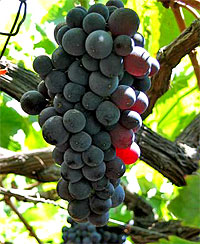 |
| Tinta. |
Tinta Negra Mole
Tinta or 'TNM' is a very versatile red grape grown around Funchal, Sao Vicente and Camara de Lobos. It is the most widely grown grape on the island with more than half of the total production coming from Tinta. Consequently, it is often referred as the 'working horse', and is counted among the Castas Boas, yet it is also one of the reasons for the decline of Madeira wine in the 19th and 20th century.
Depending on the height of the vineyard and the processing of the wine Tinta can imitate the other varieties to a great degree, which makes it so tempting for many producers. The variety is not of low a quality, as good three, five and even some ten year old blends show. However, according to many wine professionals it simply does not match the excellent quality of the other traditional varieties. My personal belief is that it has great potential as long as it is well cared for. Some of the modern colheitas and harvest wines are made entirely of Tinta grapes and they demonstrate the potentials of this grape well. Since it is easy to grow, more wine of the medium qualities like older blends and the non-frasqueira vintage wines can be made from Tinta. I think we are going to be surprised in the future about how good Tinta can really be.
The vine is robust with durable wood, medium size leaves and small black berries. The grape is a cross of Pinot Noir and Grenache. The must is red at first but the estufagem procedure clears the colour so that it acquires a green-white shine. Besides being used for blends, selected Tinta grapes from Campanário are also used for the Atlantis Rosa.
Old Wine
This does not name a grape variety but a vintage that does not consist of one single grape variety as the rules of the IVM state. This happens, when a year was good enough to declare it as a vintage but the yields of the different varieties were not enough to put them in cask and mature them at an affordable cost. In this case, as an example, Bual and Malmsey will be matured together as "Old Wine" since the regulations neither stipulate nor disqualify a Bual-Malmsey vintage. Sometimes Tinta might be added as well. Blends of different grape varieties are not uncommon anymore. The Alvada wine of the Madeira Wine Company is a blend of Malmsey and Boal. The Barbeito company has also made some wonderful blended wines from different grape varieties.
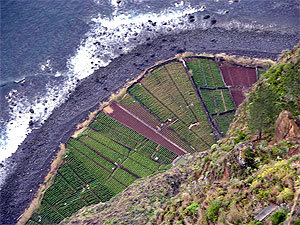 |
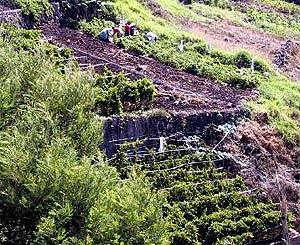 |
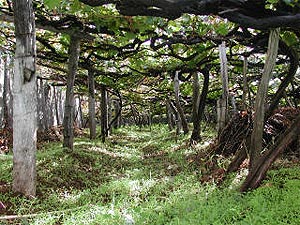 |
| The above images demonstrate the rugged, terraced terrain upon which Madeira's vineyards thrive while the bottom picture illustrates the pergola style trellising systems. |
The Making of Madeira Wine
Madeira vines are generally grown on steep terraces all over the island. The different varieties are grown in different heights above sea level. Boal and Malvasia, for example, are best grown in lower altitudes, whereas Verdelho and Sercial like the higher altitudes. At the north coast and in the Camara do Lobos area there are some larger vineyards, but usually they are very small and sometimes quite difficult to get to. There are exceptions. At Camara do Lobos, Henriques & Henriques have built a relatively large vineyard, (ten hectares), accessible by modern machinery. It is one of only two such areas at present, but the Madeira Wine Company is also planning large plantings.
About 4500 growers cultivate grapes on the island, most of them in the Camara de Lobos area. Altogether some 2000 hectares are suitable for wine-growing, but only 600 are planted with vines, since the cultivation of bananas is much more rewarding. Most wine growers also grow vegetables for themselves or for the local market between the vines. This is said to slow the development of the grapes which consequently become more aromatic and more concentrated. The grapes are mostly grown pergola-style, low in height and covered with a roof of their own leaves. This protects the grapes from the strong winds and the sometimes dramatic changes in temperature. The distance between the vines is two to three yards. The plants are usually irrigated with water from the levadas.
The harvest is mostly done manually. Malvasia is the first, the dry varieties Verdelho and Sercial last. This sounds like a paradox, but since the aromas are not backed up by ripeness, these grapes simply have to get as much sun as possible for full aroma development. The grapes are then carried to and collected on small trucks. Then they go to the winery, where the grapes are crushed and pressed. Up until the late 1970's this used to be done with feet and wooden presses. The fermented juice used to then be carried by the boracheiros in goatskins containing up to 70 liters or 15 gallons to the wine cellar down hill. (Such a load was of course tough to carry and made the men thirsty. And so there are many stories of boracheiros reaching the cellar with empty skins but heavily drunk). Today the processing and cellaring is done at the location of the press.
Since the 18th century, fermentation has taken place in a cubical concrete or stainless steel tank or, for small producers, in wooden casks with temperature control. The fermenting of the must is stopped with brandy; the time of adding the brandy depends upon the grape variety. For example, the must from the Malvasia grape gets the brandy right at the beginning of fermentation, Boal and Verdelho around the fourth day, and Sercial about a month after the fermentation started. In this way the resulting wine will be sweet or dry, depending on when the fermentation of the grape's sugar was stopped by the spirit addition. The adding of brandy is known as fortification.
Following pressing and fortification, there are two methods by which Madeira wine is produced.
However, regardless of the production technique employed, once the wine is in the 'estufa' or cask, the Madeira Wine Institute will impose a seal on the container and register it's contents.
1. The Estufa process
Young fortified wines which are not considered of the highest quality are transferred to the 'estufa'. In its simplest version, this is a large container, now usually made of stainless steel, with a pipe system in it. The pipes circulate hot water and gradually heat the wine over several days to a temperature between 45- 50 degrees Celsius (120 degrees Fahrenheit). This temperature is maintained for about three months.
Since the heating via the estufa process is rather fast, some of the wine's sugar will turn to caramel. The wine will then display the typical burnt (and sometimes rather bitter) taste of the lower qualities of Madeira wine. When the heating is finished, the wine in the estufa is allowed to cool and after a resting time (estagio) of 3 months it is then transferred into wooden casks. Depending on the intended use, this can be for three to fifteen years. There is always some air in the casks and so the wine completely oxidizes, i.e. the organic contents of the wine react with the air's oxygen and thereby change the colour, the smell and the taste of the wine. Finally the wine goes into the blend. The cellarmaster tries to keep the characteristic taste of the shippers wine by blending different wines together. The normal everyday Madeira wine is such a blend, the age given on the label indicating the youngest wine in the blend (see below). Blended wine with the name of a grape variety on the label must contain at least 85% of this grape. The other 15% can be filled up with other varieties, usually Tinta Negra Mole.
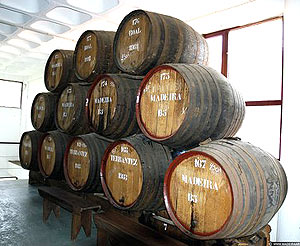 |
| Madeira wines ageing via the Canteiro method. |
2. The Canteiro process
The very best wines, and all the vintages, are treated according to the 'Canteiro' method. In this process, the casks with the young fortified wine are transferred to the roof of a large room, where they will be deliberately exposed to the sun's heat. (The beam carrying the casks is called a 'canteiro', from which the name of this method derives). The building of Henriques & Henriques in Camara do Lobos, for example, has a huge south facing window in order to collect as much heat as possible. Wines treated with the Canteiro method do not display so much caramel, but rather have a fresh fruity taste. The trade off is that Canteiro wines need much more time to develop than those produced via estufa. As a rule of thumb, 5 years canteiro equal 3 months estufa.
The wines from the canteiro method are also finished in a different way, and can become Vintage Madeiras. This means that they will stay in cask (Madeira pipes of 480 liters) for a minimum of twenty years, most of them much longer, up to one hundred years or more. During this time the sun's heat leads to further concentration and oxidation. The level of extract, acid, sugar and alcohol rises considerably over the decades (alcohol can reach up to 25% volume in wines with a very long time in cask). However, as in any form of reduction, over-concentration makes the wine undrinkable - so before occurs, it is transferred to 22 litre glass demi-johns. These demi-johns are then sealed airtight which stops further development of the wine and enables long-time storing. Finally the wine is bottled and will then rest another two years before it is put on the market. If at a later stage of development, the wine turns out to be lacking in some respect, it will be relegated for use in blends to add complexity.
Because of its complete oxidation during the maturation process, Madeira wine, like old Tawny Port, is very robust and will keep for years to come, even centuries.
Selecting, Storing & Serving Madeira
As has already being mentioned, Madeira wines are available in different styles in relation to the sugar content - specially dry, medium dry, medium sweet (medium rich), and sweet (rich) . These four basic types of Madeira are each named after the main grape variety from which they are made. Malvasia, fortified early in order to retain the richness, which is its hallmark, is a rich dark coloured and robust wine, distinctly sweet and mellow. Boal, fortified after approximately half the sugars have been converted to alcohol, is a full bodied and fruited wine with a well-rounded flavour and attractive smoky complexity. Verdelho ferments still further and is a tangy fine textured wine, elegant and dry. Sercial, the driest Madeira, light in colour and scented, is allowed to ferment until completely dry. On the label, you might also take into consideration various age categories which are as follows:
5 years old (Reserve),
10 years old (Old Reserve),
15 years old (Extra Reserve),
and more than 20 years old (Vintage), made only with the very finest wines from a exceptionally good year and exclusively from one of the traditional grapes varieties. These wines have to remain in cask for a minimum of 20 years after which they spend a further 2 years in a bottle. The remarkable longevity of Madeira is best exemplified by the Vintage, which can remain in excellent condition for 150 years and longer still in some cases.
Buying Madeira Wine
Ideally, you should buy your Madeira wine at the place with the largest selection and the lowest prices: right on the island itself. Outside of Madeira, cheap blends are sold for high prices and Vintage Madeiras that are sold to the US, Europe or Japan are usually twice or three times their domestic price. Of course, another great plus on the island is the invitation to taste. In the buildings of the producers you can sample all the blends for free and vintage bottlings for a small fee.
In some travel guides a small shop in Machico is mentioned as an insider tip to buy old Henriques & Henriques ten year old blends of Sercial and Malmsey. I would advise you not to buy any of these wines. The firm of Henriques & Henriques told me, that these are three year old Tinta blends, dating from the time when it was permitted to write Sercial on the label, even though the bottle contained Tinta. The contents are no longer drinkable, since these blends where not intended for a long storage and some of the bottles had been in the window of the shop, being exposed to the sun. (In any case, at 30 Euros + the bottles are also rather expensive).
To buy Madeira wine locally, you can try supermarkets, but you'll likely find a medium sweet or medium dry wine intended only for cooking. Nicks Wine Merchants / Vintage Direct continue to ship a range of Madeira wines, with the Henriques & Henriques collection considered a superb introduction for those wishing to learn more about the style. Since Madeira wine is going through a small renaissance as an exotic, mysterious and indestructible wine with impressive age, it has become a little easier to find. The bad side of this however, is that the stocks of good Madeira wine will be emptied even faster.
How To Store Madeira Wine
Bottles of Madeira wine should be stored in an upright position. A small gas exchange is supposed to maintain the oxidized aroma. The contents of the bottle should not touch the cork, otherwise the taste of the wine could suffer from the fact that the cork deteriorates faster than the wine. You should change the cork at least every forty years or so. You can do it yourself with the help of a manually operated corking device. If the level of wine in the bottle has dropped considerably during storage and you have several bottles of the same wine, you can sacrifice one bottle and use it to fill up the others. The remaining wine might fit into a half bottle. You could keep this half bottle for the next recorking (your children would have to do that, so label it exactly - or drink it!)
Another method to tackle ullage is to raise the level of wine by putting small, sterile, glass balls into the bottle. In any case you should take action when the level of wine reaches the lower end of the neck. Too much space for air inside over a long period is not a good thing. You should also cover exposed corks with wax to prevent them from drying out prematurely. If the bottle is corked with a short stopper, a good covering with wax or some layers of cellophane is strongly advised. Indeed, a secure way to store your vintage bottles is to seal them into a plastic bag. This will also keep the label in top condition and the bottle free from dust.
How To Serve Madeira Wine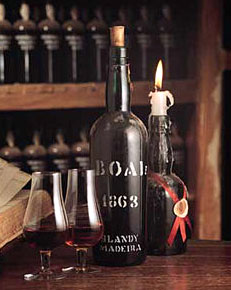 When you drink Madeira wine, be sure to serve it at room temperature. Even Sercial should not be ice cold. The colder the wine is, the less aroma and flavour you will experience. Putting ice or water into a Madeira wine, as some people do, is out of the question.
When you drink Madeira wine, be sure to serve it at room temperature. Even Sercial should not be ice cold. The colder the wine is, the less aroma and flavour you will experience. Putting ice or water into a Madeira wine, as some people do, is out of the question.
Once the decanter or the bottle of Madeira wine is on the table, it is an old-time custom to pass it clockwise, just like with port. Don't just let it sit there in front of you!
When serving very old Madeira vintage wines, keep in mind the following four pointers.
First, the bottle should be opened at least 24 hours before drinking, though 48 hours or even more can be necessary. Occasionally a bad smell called 'bottle sickness' might be present and this needs time to disappear. Decanting also helps.
Second, since the cork is usually covered with sealing wax, you will have to get through the wax first. Break the wax by carefully hitting it with a table spoon, then peel off the pieces, similar to peeling an egg. Very old bottles should not be peeled but shaved with a sharp knife.
Thirdly, the cork can be in a bad condition so be careful and use a good corkscrew to get it out. If the cork breaks, pour the wine through a filter immediately, otherwise the broken cork could affect the taste of the wine. The best way to do this is to use a new coffee filter. By filtering you will also get possible sediments out of the wine. This sediment will not affect the taste, but the wine will look better in the decanter. Once in the decanter, the wine will keep for quite some time, but a Sercial should be stored in the refrigerator.
Finally, it has been said that wine, kept over some weeks in a lead crystal decanter will acquire some of the lead. For this reason, but also because even Madeira wine does not live forever, do not take too long to drink the wine. Once a bottle is opened, the contents will also keep at least for weeks or months, though usually much longer. With Madeira, you can take your time and sip on history!
Conclusion
Madeira Wine will always have its friends. The exotic flair, the versatility, the different tastes and the easy storing make this a collectible for many wine lovers. Add the relatively cheap price for old vintages and the historic dimension of the wine and it's easy to understand why. After the low alcohol trend of the early nineties took a turn toward the other direction again, Port, Madeira and even Sherry seem to have a brighter future ahead. More and more people begin to realize that watery Pinot Grigio just doesn't fit a good five-course meal. And you just can't meditate with thin wine! So look out for the Renaissance of Madeira!
Acknowledgment: The body of this text was sourced with kind permission from Dr. Wolf Peter Reutter's Madeira Wine Guide.
* Horst Dippel: Das Wein Lexikon. 3rd Edition 1997, S. Fischer Verlag, Frankfurt am Main.
* Hugh Johnson: Hugh Johnson's pocket wine book 2000. Edition 2000, Mitchell Beazley, London.
* Hugh Johnson: Der neue Weinatlas. 28th Edition 1996, Hallwag AG, Bern.
* Hugh Johnson: Der große Johnson. 11th Edition 1997, Hallwag AG, Bern.
* Hugh Johnson: The Story of Wine. 1st Edition 1989, Mitchell Beazley, London.
* Jancis Robinson: Jancis Robinson's guide to wine grapes. 2nd Edition 1998, Oxford University Press, Oxford.
* Jancis Robinson: Das Oxford Weinlexikon. 1st Edition, Hallwag AG, Bern.
* Alex Liddell: Madeira. 1st Edition 1998, Mitchell Beazley. The by far most complete and satisfying book on Madeira ever to be printed. Read it!
* Cossart, Noel: Madeira - the island vineyard, 1984, Christie's Wine Publications, London.
* H. Warner Allen: Portweine und Madeira, 1962.
* Croft-Cooke, Rupert: Madeira, 1961, Putnam & Company, London.
* Simon, Andre L., Craig, E.: Madeira - Wine, Cakes & Sauce, 1933, London.
* L. Irmes, P. E. Grimm: Madeira, 1973, Gloria-Verlag, Spreitenbach.
* Henry Vizetelly: Facts about Port and Madeira. 1890, London, Reprint, Baltimore.
* Silas Weir Mitchell: A Madeira Party. Reprint 1975, Corti Brothers, Sacramento. This reprint also contains an essay on Silas Weir Mitchell and a very interesting essay on "Our Madeira Tradition" by Roy Brady.
* John Radford, Stephen Brook: Fortified and sweet wines, 2000. Mitchell Beazley Publishers, Octopus Publishing Company Ltd., London.
* Michael Broadbent: Michael Broadbent's Vintage Wine - fifty years of tasting three centuries of wines. 2002, published in Great-Britain by Webster's, in the U.S. by Harcourt.
